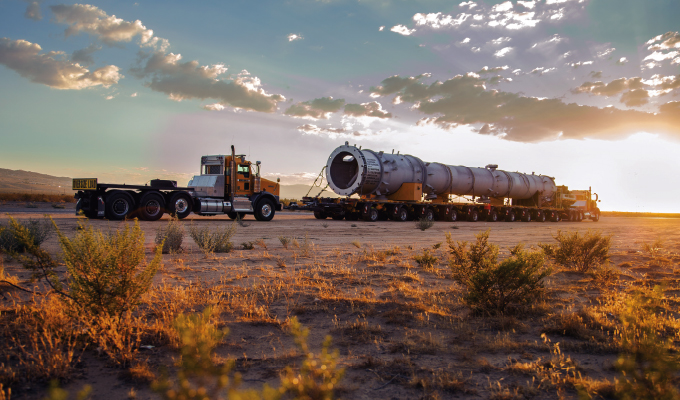Securing cargo, particularly heavy cargo on open-deck, hydraulic, spread axle, tank hauler, lowbed, flat bed, gooseneck, and ultra-heavy capacity trailers can tax the knowledge of even seasoned professionals. With the never-ending variety of circumstances and complex challenges, getting cargo securement right is not only an art, but a science.
Vehicle operators and others responsible for securing a payload must become intimately familiar with federal regulations and then how these apply to each vehicle’s individual cargo. They must also possess a basic understanding of their cargo’s shape, weight, geometric form, and how physical forces will act on the load once it is in motion.
Any misstep along the way, be it a calculation error or a wrong securement method, can result in citations, CSA points accumulation, or an out-of-service violation. The main objective is to avoid a cargo securement failure that was otherwise preventable. Lives, capital, equipment, reputations, and businesses literally hang in the balance. So, it’s important to get the balance correct.
IT’S COMPLICATED
Everything from boulders to crushed vehicles to metal coils, pipe, and lumber are transported each day. Loads such as articulating equipment and large demethanizer vessels must reach remote and often off-highway worksites. Oversized loads, like 56-ton wind turbine nacelles and their accompanying blades are becoming more and more frequent sights on highways.
Fleets like my customer, Northwest Logistics Heavy Haul, have built businesses around hauling specialized types of cargo and have become experts in the processes and techniques of securing it for transport. Those who deal with a wide spectrum of cargo types may have a harder time keeping all the variables in mind, which can lead to improper securement and potential issues.
Of paramount concern is the safety of the driving public, but worker well-being must be considered as well. Once cargo is assessed and securement methods considered and calculated, the critical work of securing the load can begin. The securement process itself can present certain risks, as it often requires that workers climb in, on, and around sometimes heavy, unstable, and sharp cargo items to attach chain or other heavy-duty restraints, which themselves can be heavy and unwieldy.
IT’S THE LAW
Fleets and professional drivers must have a strong working knowledge of federal regulations. In the United States, the Federal Motor Carrier Safety Administration (FMCSA) establishes the regulations. The FMCSA is an agency in the United States Department of Transportation (USDOT) that regulates the American trucking industry as a whole. The agency provides information regarding safety as required by the Federal Motor Carrier Safety Regulations Parts 392 and 393. The Driver’s Handbook on Cargo Securement by the FMCSA also classifies different commodities and stipulates the standards for proper securement of these specific load types. These are:
- Logs,
- Dressed lumber and similar building products,
- Metal coils,
- Paper rolls,
- Concrete pipe-loaded crosswise on a platform-vehicle,
- Intermodal containers,
- Automobiles, vans and light trucks,
- Heavy vehicles, equipment, and machinery,
- Flattened or crushed vehicles,
- Roll-on/ roll-off hook-lift containers, and
- Large boulders
FMCSA regulations are informed by standards published by The Web Sling and Tie Down Association (WSTDA), regarding recommended standard specification for load securement devices, including synthetic web tie-downs, winches used with web tie-downs, and load binders used with chain tie-downs. The WSTDA standards detail definitions, construction, testing procedures, operating practices for tie-downs, winches, and load binders. The National Association of Chain Manufacturers (NACM) writes the standards for steel chain used for load securement.
FORCES OF NATURE
Once on the move, physical forces act upon cargo. To keep cargo stable and in position, one must comprehend the basic forces exerted and how they can cause a payload to shift, tip, slide, and otherwise become unstable.
The gravitational force equivalent, commonly referred to as “g-force,” is the most important part of the equation, represented as “g.” One g is basically equal to an object’s weight on earth, and knowing the weight of one’s cargo is necessary to understand criteria for the breaking strength and related working load limit (WLL) of tie-down assemblies and other attachments or fastening devices. All such devices are manufactured to include clearly marked information on WLL. These must remain legible for tie-down assemblies to remain in service.
According to FMCSA regulations for performance criteria, cargo securement devices and systems must be capable of withstanding these three forces, applied separately:
- 0.8 g (or 80% of the weight of the cargo) deceleration in the forward direction;
- 0.5 g (or 50% of the weight of the cargo) acceleration in the rearward direction; and
- 0.5 g (or 50% of the weight of the cargo) acceleration in a lateral direction.
Securement systems must provide a downward force equivalent to at least 20% of the weight of the article of cargo if the article is not fully contained within the structure of a vehicle.
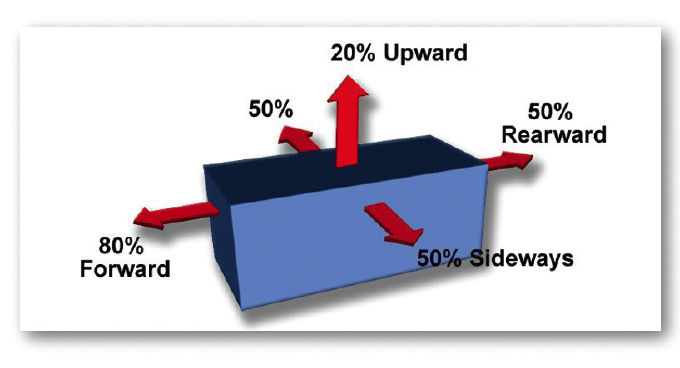
WSTDA established the design factor of tie-down straps as 3:1 or a WLL of 1/3 of the tie-down strap’s breaking strength. For chains, the design factor is 4:1 or a WLL of 1/4 of the chain’s breaking strength. The combined ratings of all the straps or chains must equal at least one-half the load’s total weight. If the load is 80,000 lbs, the aggregate WLL of all the tie-downs together must equal at least 40,000 lbs.
ALL ABOUT ANGLES
Along with FMCSA guidelines, one should ensure that these critical conditions are met:
- The cargo should be fully contained and supported by the flatbed structure and should be restrained from any horizontal or vertical movement,
- The cargo should be fully restrained from shifting or tipping over by the truck’s structure and blocking implements of adequate strength, and
- The cargo should be completely immobilized by appropriately applied tie-downs so it can withstand the required g-forces in all directions.
- Consideration should be given to the angle from the horizontal tie-down to its anchor point on the trailer, as this affects the downward pressure. The lower the angle, the less pressure and friction against the load. This may result in the need for additional tie-downs.
Often overlooked, the angle of a tie-down assembly can significantly decrease the amount of downward pressure exerted on a load, reducing friction between tiers of stacked cargo, and ultimately, against the deck. As an example, at a 30-degree angle, a tie-down may only be able to exert 50% of its effective downward pressure, which under certain circumstances may allow some cargo, including sheeted materials to slide or become unstable.
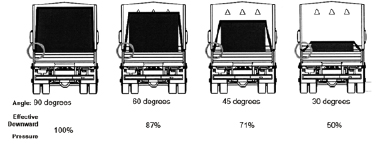
Unfortunately, the noted angle factors assume equal tension on all parts of the tie-down assembly, but in reality, tie-down tension varies from side-to-side due to friction on the cargo. So, the effective downward pressure impact on actual load securement is compounded.
In all cases, chains and straps face limits on cuts, breaks, and other defects as defined in a Defect Classification Table in the CVSA guidelines. Inspectors use the Out of Service Guideline when examining a vehicle’s cargo securement. It’s wise to make chain and strap inspection a part of any cargo securement application process.
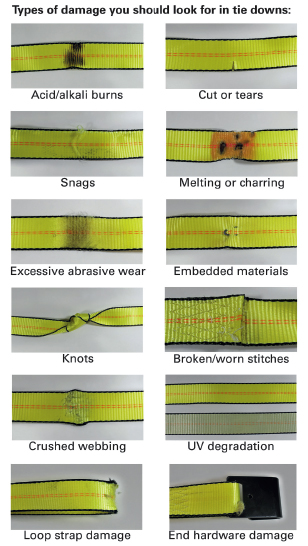
DON’T FAIL TO PLAN
Safe securement begins with a clean, safe, and structurally sound transport vehicle. It is of utmost importance to inspect and confirm that the critical components of the vehicle that will be involved in the cargo’s securement are in good condition and are not weakened or corroded. It is particularly critical that the deck structure and the anchor points for the tie-down are not compromised in any way.
The securement system or systems one chooses should depend exclusively on the characteristics of the load. Begin by considering several key factors. Is the cargo configured as one piece or as constituent pieces? Will it be prone to sliding? Does it have sharp corners that could cut through webbing? Does it have engineered anchor points that allow for “direct” securement attaching to the article or nothing to attach to, requiring “indirect” securement that passes through, over or around the article? The cargo itself must also be strong enough to withstand the pressure of securement without becoming damaged.
Fortunately, in addition to traditional cargo securement and fastening devices like binders, winches, and hooks, there are a variety of tools that can be employed to enhance cargo securement efficiency and effectiveness. Wood or rubber chocks can be added to aid stability. Corner protectors can be used to blunt sharp edges that could otherwise cut webbing and also help to distribute downward force and avoid edge-crushing damage to soft cargo like foam insulation or asphalt shingles. Textile chains, like the Doleco® DoNova® PowerLift Chain Slings and PowerLash Textile Lashing Chain and Tie Down System are about 85% lighter than equivalent strength steel chain and won’t scratch finished cargo surfaces. The application of netting can unitize otherwise unstable cargo, and anti-slip mats can increase the coefficient of friction between the load and the load-bearing surface.
CHANGE IS INEVITABLE
Cargo can be expertly secured at the outset of transit, but once in motion, everything can and will change. Per FMCSA 392.9 Inspection of Cargo, Cargo Securement Devices and Systems, drivers are required to inspect cargo before driving the vehicle and no more than 49.7 miles (80 kilometers) from where the cargo is loaded.
Periodic inspection of cargo securement devices and systems is mandatory when:
- There is a change of duty status for the driver, OR
- The vehicle has been driven more than three hours, OR
- The vehicle has been driven for about 150 miles (240 kilometers)
Be in compliance. When in doubt, visit the Federal Motor Carrier Safety Administration website at www.fmcsa.dot.gov for the most up-to-date regulations in the US.
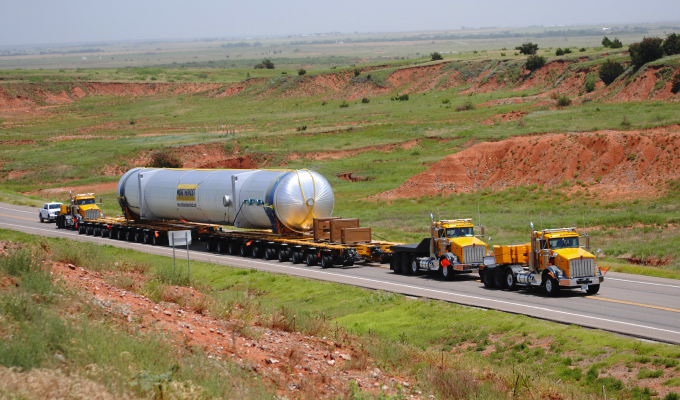
ABOUT THE AUTHOR
Ralph Abato has been an active member of the Web Sling and Tie Down Association (WSTDA) for more than three decades. He currently serves as vice chair of the Technical Resource Committee and has previously served as vice president of the association and Technical Chairman of both Tie Down and Sling committees. He continues to serve on WSTDA’s Board of Directors. Abato is also president and managing director at Doleco® USA. Find out more, visit www.doleco-usa.com.


